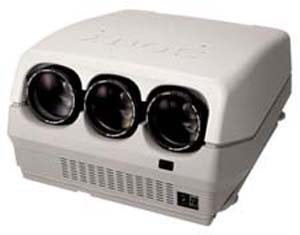 |
CRT Primer
|
Updated: April 2006 |
Sony
Sony was one of the pioneers
of flat screen front projection TV’s.
Sony made a series of wooden box KP-XXXX
in the early to mid 1980’s that were
designed to be projected onto a 6’
curved screen, and later these could
also be used on a flat screen. Video
only projectors, and most had a speaker
and TV tuner built in. Very reliable
sets, but I have not seen one in years.
Sony came out with their first flat
screen CRT video projector in about
1983-1984 called the VPH-722. Later this
model became the VPH-1020 and 2020, with
little differences between each of
these. 7” Sony Es focus tubes, analog
convergence, 500 lumens or so.
Convection cooled, very reliable, and
occasionally I still sell these sets.
Between 1986 and 1996 Sony came out with
a number of their 10XX series, including
the VPH-1020, 2020, 1030, 1031, 1040,
1041, 1042, 1044, 1000, and 1001. With
the exception of the 1030 and 1031,
these were all video grade sets, had
analog convergence and had slight
variations between the models. Some had
S-video inputs, some had slightly
brighter tubes, etc. etc. All very
reliable sets, small footprint, and most
had 2 or 3 small cooling fans in them.
600 to 750 lumens. In general, the
higher the model number, the newer it
was, but that changed with the
introduction of the 1000 and 1001 in
about 1995. I have no idea why Sony
changed their numbering sequence...All
of the above sets used Sony 7” ES focus
tubes.
The Sony 1030 and 1031 scanned to 26 Khz
and 36 Khz respectively. Other than that, the
overall picture was very similar to the rest of the 10XX series.

Sony 1031
In 1990, Sony introduced a higher end
model, the 1270. It came out in 5
different versions from 1990 to 1997,
the 1270, 1271, 272, 1251 and 1252. All
had slight variations of the same basic
chassis, and all used Sony 8” ES
focusing tubes. The 1270 had 650 lumens
and 75 Khz scanning rate, the 1251 had
56 Khz scanning rate and 750 lumens, the
1252 had 61,5 Khz scanning rate and 750
lumens.
Each of these sets had 9 zones of fine
convergence adjustments within the
digital convergence settings.
The 1252 and 1272 had 65 and 92 Khz
scanning rate respectively, and had 21
points of fine tuning, making these sets
a bit more desirable for high definition
installations. For all intents and
purposes though, the entire 12XX line
had identical pictures up to line
tripling.
The Sony 1292 was introduced in 1995 as
Sony’s flagship model. 110 Khz scan
rate, 1200 lumens, 21 point digital
convergence, and 9” EM focus tubes. the
basic image was very similar to the 12XX
series, but the larger tubes and EM
focus made for a razor sharp picture.
Very large and heavy beasts.

Sony 1252
The entire Sony 12XX line of projectors
is known to be quite noisy due to the
fans used to cool the projector. The
1292 is even noisier than the other
models due to a total of 14 fans. A
hush box is recommended for these Sony's
if the noise bothers you.
In about 1997, Sony changed their
projector line-up, and introduced the
Sony D50, D70, G70 and G90 models,
The D series was 7” ES focusing, the G70 was 8”
EM focusing and
the G90 was 9” EM focusing. All
were significantly quieter than the 12XX
series, had expanded digital convergence
set ups, and gave an excellent picture.
The G70 and G90 have LC tubes.
All of the later Sony models have
component inputs along with video,
S-video and RGB, and had options
available for internal line doublers.
There are far fewer modules and parts
available for the later Sony sets on the
used market than the earlier 12XX series
sets.
Sony strengths and weaknesses

Sony D50
The entire Sony line-up of projectors is known for their reliability, and
failures during normal use are far and few between. The 10XX series was not really designed as a modular set, and thus
the in field troubleshooting and
repair is difficult. Almost all of these sets have to be sent to a service tech
when a failure occurs. Power supply and convergence board problems are the most
common source of failure.
Failures of fans have been seen, bad solder joints occur, and the odd
component failure does happen, but in general Sony parts from Sony are less
expensive than the equivalent from Barco. Again, there are many surplus Sony
projectors on the market, and good used parts are easy to find.
The Sony manuals are extremely well written and setup is almost as easy as
the Barcos.
|
|




